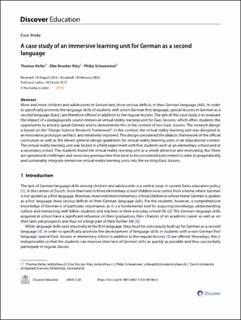Please use this identifier to cite or link to this item:
https://doi.org/10.21256/zhaw-30409| Publication type: | Article in scientific journal |
| Type of review: | Peer review (publication) |
| Title: | A case study of an immersive learning unit for German as a second language |
| Authors: | Keller, Thomas Brucker-Kley, Elke Schwammel, Philip |
| et. al: | No |
| DOI: | 10.1007/s44217-024-00106-w 10.21256/zhaw-30409 |
| Published in: | Discover Education |
| Volume(Issue): | 3 |
| Issue: | 28 |
| Issue Date: | 8-Mar-2024 |
| Publisher / Ed. Institution: | Springer |
| ISSN: | 2731-5525 |
| Language: | English |
| Subjects: | German as second language; Switzerland; Zurich; Virtual reality; Immersive learning; Spracherwerb; Deutsch als Zweitsprache; Immersives Lernen |
| Subject (DDC): | 006: Special computer methods 401.9: Psycholinguistics and sociolinguistics 430: German |
| Abstract: | More and more children and adolescents in Switzerland show serious deficits in their German language skills. In order to specifically promote the language skills of students with a non-German first language, special lessons in German as a second language (GasL) are therefore offered in addition to the regular lessons. The aim of this case study is to evaluate the impact of a pedagogically sound immersive virtual reality learning unit for GasL lessons, which offers students the opportunity to actively speak German and to demonstrate this in the context of two GasL lessons. The research design is based on the “Design Science Research Framework”. In this context, the virtual reality learning unit was designed as an innovative prototype (artifact) and iteratively improved. The design considered the didactic framework of the official curriculum as well as the eleven general design guidelines for virtual reality learning units in an educational context. The virtual reality learning unit was tested in a field experiment with five students each at an elementary school and at a secondary school. The students found the virtual reality learning unit as a whole attractive and motivating. But there are operational challenges and necessary prerequisites that have to be considered and created in order to pragmatically and sustainably integrate immersive virtual reality learning units into the existing GasL lessons. |
| URI: | https://digitalcollection.zhaw.ch/handle/11475/30409 |
| Fulltext version: | Published version |
| License (according to publishing contract): | CC BY 4.0: Attribution 4.0 International |
| Departement: | School of Management and Law |
| Organisational Unit: | Institute of Business Information Technology (IWI) |
| Appears in collections: | Publikationen School of Management and Law |
Files in This Item:
| File | Description | Size | Format | |
|---|---|---|---|---|
| 2024_Keller-etal_Case-study-immersive-learning-GasL_DiscoverEducation.pdf | 1.19 MB | Adobe PDF |  View/Open |
Show full item record
Keller, T., Brucker-Kley, E., & Schwammel, P. (2024). A case study of an immersive learning unit for German as a second language. Discover Education, 3(28). https://doi.org/10.1007/s44217-024-00106-w
Keller, T., Brucker-Kley, E. and Schwammel, P. (2024) ‘A case study of an immersive learning unit for German as a second language’, Discover Education, 3(28). Available at: https://doi.org/10.1007/s44217-024-00106-w.
T. Keller, E. Brucker-Kley, and P. Schwammel, “A case study of an immersive learning unit for German as a second language,” Discover Education, vol. 3, no. 28, Mar. 2024, doi: 10.1007/s44217-024-00106-w.
KELLER, Thomas, Elke BRUCKER-KLEY und Philip SCHWAMMEL, 2024. A case study of an immersive learning unit for German as a second language. Discover Education. 8 März 2024. Bd. 3, Nr. 28. DOI 10.1007/s44217-024-00106-w
Keller, Thomas, Elke Brucker-Kley, and Philip Schwammel. 2024. “A Case Study of an Immersive Learning Unit for German as a Second Language.” Discover Education 3 (28). https://doi.org/10.1007/s44217-024-00106-w.
Keller, Thomas, et al. “A Case Study of an Immersive Learning Unit for German as a Second Language.” Discover Education, vol. 3, no. 28, Mar. 2024, https://doi.org/10.1007/s44217-024-00106-w.
Items in DSpace are protected by copyright, with all rights reserved, unless otherwise indicated.